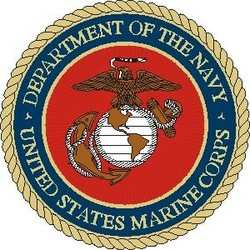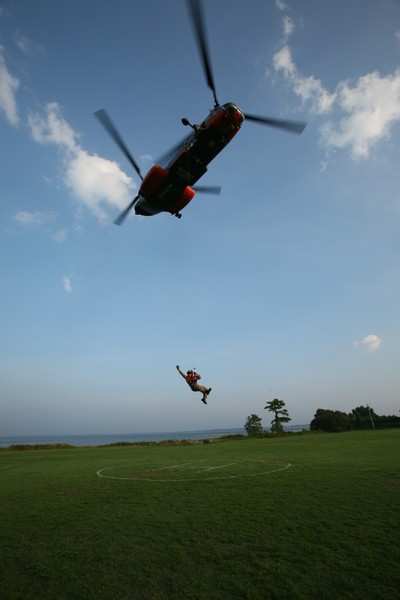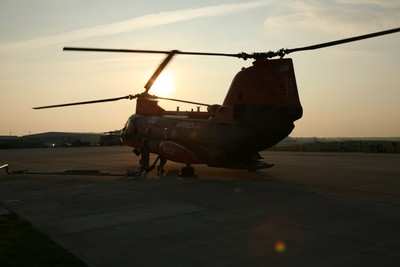 In addition to its duties as a transport squadron, Marine
Transport Squadron 1 has two unique missions aboard the air station
– search and rescue operations and community relations. VMR-1
flew across the Neuse River to Arapahoe, N.C., and demonstrated its
SAR capabilities for the boys and girls at Camp Sea Gull, July
28.
In addition to its duties as a transport squadron, Marine
Transport Squadron 1 has two unique missions aboard the air station
– search and rescue operations and community relations. VMR-1
flew across the Neuse River to Arapahoe, N.C., and demonstrated its
SAR capabilities for the boys and girls at Camp Sea Gull, July
28.
Campers flocked to the squadron’s HH-46E, known as Pedro,
and were able to board the aircraft and see what components the
specialized Sea Knight has. “We support tactical aircraft at
Cherry Point, which is basically any ejection seat equipped
aircraft with needs such as search and rescue,” said Capt.
Brian Santucci, the search and rescue officer in charge with VMR-1.
“We’re also able to support the local
community.”
Santucci stood near Pedro as the campers were coming out and
fielded a few questions.
“This is a static display and this is a way we can
interact with the local community and show them what we do in the
Marine Corps,” Santucci said. “We do this a couple of
times a month. We have a pretty big presence in the local community
and we like doing this to show them we’re out there.
“We come out and spend some time answering questions about
the helicopter,” Santucci said.
Pedro can be seen demonstrating its capabilities for many
different agencies including other branches of the military. The
squadron does displays for Coast Guard stations, elementary
schools, emergency medical service stations and fire stations, said
Petty Officer 2nd Class Lawrence G. Courtney, an in-flight medic
with VMR-1.
For Camp Sea Gull, Pedro went far beyond just a static display
and performed a simulated rescue mission. “We’re going
to do something pretty simple,” Santucci said.
“We’re going to leave one of our crewmembers here and
we’re going to take off. Then we’re going to come back
and get him.”
Pedro performed a takeoff for the campers and circled the air.
Upon approach, a hook was lowered 75 feet to the waiting Marine to
hoist him to the aircraft.

“That’s normally how we attempt a rescue,”
Santucci said.
“It’s an amazing feeling,” said Sgt. Michael
L. Falzone, a rescue swimmer with VMR-1 who was rescued during the
simulated mission. “It’s not everyday that you get
hoisted up 75 feet. I’ve never done a hoisting during a
static display, so it was a little bonus.”
The crew’s static display showed its onlookers more than
the spectacle of seeing a Marine hoisted 75 feet into the air. It
also gave the campers a view of the squadron’s primary
mission.
“Our mission is kind of unique in the Marine Corps,”
Santucci said.
The Roadrunners provide a means of transportation and support
for local emergencies. Without bypassing other government agencies,
Pedro is able to perform operations that can be burdensome to
smaller units.
“Typically what will happen is that the hospitals will try
ambulances first and then other civilian medical transportation
aircraft,” Santucci said. “If these are unavailable,
the weather is really bad, or if the civilian aircraft can’t
make it, they’ll call us.”
“A lot of the time we take missions civilian units
can’t,” Santucci said. “Predominantly because
we’re capable of flying at night and during bad
weather.” The crew chief’s role during the rescue
mission is quite vital and it was demonstrated in a manner that not
only entertained the campers but also educated them as well.

“Anything that goes on in the back of the aircraft, I take
care of that,” said Sgt. Christopher O. Pierce, a crew chief
with VMR-1. “Once we get into the actual rescue part of it, I
get these guys in the water or on the ground safely. Whatever gear
our swimmer is calling for, I get that ready and send it down to
him.”
The Marines of VMR-1 flew away from Camp Sea Gull as the campers
waved. Pedro’s dual mission left an overwhelmingly positive
impression. “It’s always fun to go out there and
interact with the community,” Pierce said. [ANN Salutes Lance
Cpl. Michael Curvin, Marine Corps Air Station Cherry Point]
 Senator Pushes FAA to Accelerate Rocket Launch Licensing
Senator Pushes FAA to Accelerate Rocket Launch Licensing Classic Aero-TV: RJ Gritter - Part of Aviations Bright New Future
Classic Aero-TV: RJ Gritter - Part of Aviations Bright New Future Aero-FAQ: Dave Juwel's Aviation Marketing Stories -- ITBOA BNITBOB
Aero-FAQ: Dave Juwel's Aviation Marketing Stories -- ITBOA BNITBOB ANN's Daily Aero-Linx (10.27.24)
ANN's Daily Aero-Linx (10.27.24) ANN's Daily Aero-Term (10.27.24): Clearance Void If Not Off By (Time)
ANN's Daily Aero-Term (10.27.24): Clearance Void If Not Off By (Time)





